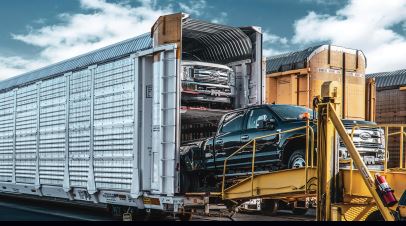Uncategorized
Ohio Train Wreck: The Truth about Railroad Cars

We’re going to talk about railroad cars now, to be specific the truth about train cars. This applies in a general way to all train cars. But, specifically, a lot of it applies to those train cars that ended up in a pile in Ohio.

Who am I to be telling you this?
I was only in the specialty chemical business for a few dozen years, and had prior railroad experience. Also, I have plenty of experience auditing bulk loading and unloading facilities in major chemical plants. On top of that, much to the annoyance of some of the auditees, I spend a lot of time on these things because they’re important.
I have a couple of other posts on this disaster:
The Truth About Railroad Cars
Let’s start with the basics. You know how everybody has communications, and cellphones, and screens and we’re living in a golden age? The pace of technology has advanced so much, and things are so much better now?
Well, train cars are the opposite of that. Train cars are famous because they’re basically the same as they were 100 years ago.
The Janney Coupler, which is the mechanism to attach the cars together was patented in 1897.
The Westinghouse air brake was patented in 1898, and is still the predominant way of stopping a train. Those air hoses that run from car to car are connected to a series of tanks, and a compressor in the engine provides compressed air that operates the brake mechanism. There are some more recent control system improvements, but basically not.

Is this a case of shark evolution? No, it’s an example of “Brontosaurostructure”, where an industry is so big, and so old, that it’s impossible to change it. The capital expense and general expense to retrofit the whole system to some new technology is cost-prohibitive.
Here’s a video:
Who Owns All Of Those Railroad Cars?
Anybody can own a rail car. In fact, it’s an interesting business proposition. The most common people who own rail cars are people who use rail cars all the time and need their own. Here is an example: Carbon black is a nasty material, so much so that the rail cars used to haul it are unusable for anything else. So if you’re a carbon black manufacturer, you might own your own rolling stock, just so you won’t have to wait in line to ship your product.
That is not to say that the carbon black companies “need” to own their cars. they can just as well get into long term lease agreements with someone who is in that business.
There is a link below for Trinity Rail, who claims to be North America’s largest rail car leasing company. According to their website, they own 140,000 rail cars. The railroads themselves, like Norfolk Southern also own only about 54,000 rail cars. Trinity actually manufactures the cars in addition to leasing them out.

What is the point in this? Well, it’s basically the same as truck leasing, and over the road trailer leasing. The leasing company gets to take non-cash tax writeoffs (depreciation) and so there is a business in borrowing money, buying capital intense equipment, leasing the cars out, getting tax benefits, and collecting cash. It’s a bit dependent on the overall economy, but there will be a need for their equipment for the foreseeable future.
Trinity Industries has actually done reasonably well as an investment. Here’s the stock chart. Of course they do similar things in other industries along with railroads.

Who are these guys?
The usual suspects. I have linked the top shareholders in this company, and it’s people like the Vanguard Group and Blackrock. 75% of the float is institutional investors and mutual funds.
Steady, not going anywhere, and they actually make money on the side (if they’re lucky) in “investing activities”. You can look at their annual report, this thing is not for everybody because it is boring.
It’s not a license to print money, because they do have some competition.
This being the case, when a rail car breaks down, who fixes it? Well, there are people in that business too. Trinity has a network of rail car service facilities, and there are ways to get railway cars fixed if you need to.
So, there has to be some system to inspect these rail cars, and call whoever owns it, and get them to come out and fix it, right? Well, that’s the way it’s supposed to work.
So do these railroad cars ever get inspected?
For a price, you can find someone who will inspect your rail car. The railroads offer this service, and there are third party car inspection services. Is there anybody keeping track as to whether a given car is inspected periodically?
There’s a law that says that when a car is put into a train, it needs to be inspected by a “designated inspector.” What does it take to be one of those? Well, for a few dollars, it seems that you, too can take a rail car inspection course. There is a suggestion that the pay is around $11 an hour.
Ultimately it’s the job of the train crew and/or the “carman” to inspect the railway cars before they’re put into the train. I put a link to a CSX carman down below. There are no educational requirements, but you have to pass the test, and have some welding aptitude.
The link below to CFR215 is interesting. It gives the inspection points and what to look for on a railroad car. It’s basically cracks, breaks, failure points, and signs of overheating. Maybe you can visually inspect these things and see whether they’re going to cause a problem.
Inspection Scenario
So I can think of a couple of refineries I’ve been at, that do bulk loading and unloading of chemicals. There’s a crew person that runs a vehicle that is powerful enough to spot a train car. They place the train under a bulk handling spout, or over one.
There is also usually an operator that attaches the equipment. The more responsible companies have a checklist by which the operators are expected to at least look at the car and note any defects.
The cars go off to a railroad yard nearby, where they are ultimately put into a train.
So it’s cold and dark, and they’re putting a train together. There is an employee called a “car toad” that is supposed to do the work of inspecting the car, confirming no defects, and confirming that it’s attached properly. This fellow is supposed to notice any cracks in the bearing housing, for example, see if there are any signs of overheating, or any other issues that might cause the car to be tagged out.
The Car Toad Dilemma
It’s a Federal requirement that he or she does his job. Is there objective evidence of this happening? Is there car paperwork of some kind that says the last time a given car was inspected? At this point, the inspectors have a handheld device that captures the information. So, your audit trail can start there, maybe.
How is this working? Well, there’s pressure on the part of the railroad for the employee not to tag out a car, and not to tag out too many cars. If an employee does this, it causes the railroad to have to do repair work and/or delay shipping. Do they want to do that?
There’s a case I’ve linked below where the CSX railroad basically knowingly released bad cars into the world, a wreck ensued, and someone was injured.
There’s the catch. The inspector is not objective. He or she is a railroad employee and there is an incentive to get the car moving. In the case down below, an employee who is zealously doing his job as a rail inspector was chastised for doing too good of a job, and there was evidence.
Here’s where we get back to the relationship between the Union and The Railroad, which we all know is “tense.”
The Defective Rail Car in the Ohio Train Wreck
I am much more interested in the boxcar with the hot box than the 20 cars worth of chemicals.
The railroad should be able to trace that thing back to the source, figure out who “inspected it” and when, and look at objective evidence that it was properly released.
Maybe.
All a lawyer would have to do is plant the seed of doubt in a jury as to whether this car was properly inspected.
This would be easier to do if the “inspector” was some kind of low wage employee that was in a dispute with management, some cold dark night in a railway yard in the midwest.
An efficient lawyer would already know whether the railroad, Norfolk Southern, was involved in any other legal actions like the one below.
For that matter, the records for that car would be pulled, as well as maintenance records for all of the other cars on that railroad. Since railroad car technology has been around for a long time, some crafty lawyer and a statistician should know how many of these things are flunked in a given week, systemwide, and be able to figure out whether a given inspection location was working properly.
And, as in the previous case, if it is found that there are flaws in the record keeping system, that alone will have them screaming.
It’s going to be up to the railroad to prove that their inspection system is effective, particularly at the location where our suspect car was added to the train.
Audit Trails
Here’s a little table of potential audit trails that I, as an ISO auditor, would start with.
| Evidence | Line of Inquiry |
| Last inspector | Current training certificate, valid training certificate, eyesight, experience, working conditions at the time of the inspection, history of discipline issues, relationship with supervision and management |
| Inspection System | Recent escapes, overall system effectiveness, percentage of similar cars with inspection issues |
| Railroad Car Manufacturer | Similar defects and product issues, known defect |
| Repair Service | When is the last time this car needed repairs? Who did the repair? Could there be a repair failure |
| Railroad | History of whitewashing car inspections? Previous lawsuits? |
| Component Manufacturer | Similar defects in other railroad cars? History of |
| Railroad Car Owner | History of maintenance issues? Allowing cars to go beyond recommended maintenance interval or rebuilding interval? Maintenance being done as required? |
Do you know what’s really problematic? It’s that none of this is third-party validated. This situation is no different. Did an independent third party validate any of this, or are the investigators going to have to take the railroad’s word for self-policing.
There is supposedly a role in this for the Federal Railroad Administration, but, as we have indicated previously, the government is struggling to do this sort of thing right now. They can’t do anything more than check a sampling.
There is an FRA database that is available to see how they’re doing.
Links and References
http://www.trainhistory.net/railway-history/railroad-cars/#:~:text=The%20first%20railroad%20cars%20predate,for%20specific%20types%20of%20load.
https://en.wikipedia.org/wiki/Janney_coupler
https://en.wikipedia.org/wiki/Railway_air_brake
https://patents.google.com/patent/US609484A/en
https://s25.q4cdn.com/774532758/files/doc_financials/2021/ar/2021-Annual-Report-FINAL.pdf
https://money.cnn.com/quote/shareholders/shareholders.html?symb=TRN&subView=institutional
https://www.bvna.com/building-infrastructure/services/inspections/rail-freight-car-inspections
Freight Car Inspection
https://www.ecfr.gov/current/title-49/subtitle-B/chapter-II/part-215
https://www.csx.com/index.cfm/working-at-csx/job-overviews/mechanical/carman/
https://safetydata.fra.dot.gov/OfficeofSafety/default.aspx
![]()










